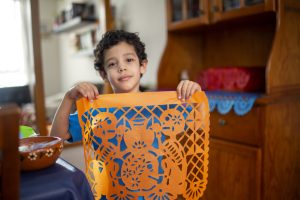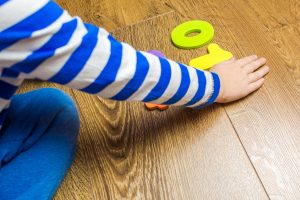What comes to mind when you think of doing math? Do you picture yourself huddled over a desk, racing to finish your multiplication facts? Do you imagine helping your child complete homework problems? These certainly are examples of doing math but so are many other activities we engage in throughout our day. Math is everywhere!
Many times, we rely on mathematical skills without even realizing it. For example, when we plan our day, schedule our commute, prepare a meal, alter a recipe, bag groceries, or estimate the time it takes to complete a task, we are practicing math. Once we uncover the math around us, we can uncover it for children, by intentionally enriching our conversations with math language and concepts. This enrichment builds children’s mathematics vocabulary and deepens their mathematical thinking.
Work Math into Everyday Conversation
At a free event promoting family engagement in mathematics this past spring in Washington, D.C., we encouraged parents of preschoolers to uncover the mathematics in everyday situations and explained that by doing so they could increase their own and their child’s mathematics vocabulary. Specifically, we showed parents written sentences that many families make about their activities or routines and asked parents to generate ideas for turning those everyday statements into math statements. Parents and older siblings seemed excited by the number of different ways they could embed math into everyday occurrences!
Here are a few examples of how parents and others who participated turned the everyday statements we provided (in bold) into math-enriched statements.
All the ingredients go in this bowl.
- Do you think they will fit?
- Which ingredients are wet and which are dry? We’ll put the dry ones in this bowl.
- Mix in two cups of milk and add 1/4 of a cup of sugar to this bowl.
- Let’s make cookies. We need 30 cookies, but our recipe makes only 12. Let’s increase the ingredients so we can make exactly 30.
- We need to add the dry ingredients slowly. Add one cup of dry ingredients, then stir for 10 seconds, then add another cup of dry ingredients, and stir again. Keep doing this until all of the dry ingredients are used and everything is mixed together!
I’m noticing lots of animals here.
- Let’s count the animals!
- Which animals have fur and which do not?
- How many more dogs are there than cats?
- Which of the animals are two-legged? Which are four-legged?
- These animals are different sizes. Which is the biggest animal that we can see?
- Some of the animals move faster than others.
It’s busy today, look at all the cars driving by.
- There is a lot of traffic today. Can you count the number of cars going by?
- Which color is the most common car color on the road today?
- About what percent of the cars that pass by are blue?
- How do the drivers know how fast they can drive?
- Which lane of cars is going faster and which is going slower?
Let’s have a picnic over there.
- Let’s have a picnic next to the pool.
- Let’s have a picnic over there; we should sit in a circle under the tree.
- We can have a picnic at the top of that hill. How many steps will it take us to climb to the top?
- Let’s carry these to the picnic area over there. The picnic basket is heavy. What can I remove to make it lighter?
- We can have a picnic over there, but this picnic basket is too heavy. I have six bottles of juice. If each person can carry two bottles, how many helpers do I need?
- The trash can is 15 feet away from that picnic table, but that other picnic table is farther from the trash can, so let’s sit there.
- Let’s walk to the area that is triangulated by those trees for our picnic. How many steps away do you think it is?
- Our picnic is about 0.5 miles north of here. When we arrive at the biggest tree, we will take a left and walk 20 feet.
- We need to be back home by 3:00 p.m. How much time do we have for our picnic?
Let’s race to the monkey bars.
- How many seconds will it take us to get there?
- How many steps (or feet or yards) away are the monkey bars?
- How many steps is it to the monkey bars? Let’s estimate, and then see how close our answer is!
- Can you count the bars by 2’s? by 5’s?
- Why did it take me fewer steps to get here?
- To use the monkey bars, hold on with both hands to start. Then swing your right hand to the bar in front of you, and your left hand to the bar after that. This way, you will get into a rhythm and get across smoothly!
Look at the garden.
- What patterns do you see in the flower petals?
- Look at the symmetrical shapes in the garden.
- Look at how evenly spaced the rows are. There is a row of vegetables and then about 5 inches of dirt. This repeats across the width of the whole garden!
- What is the ratio of orange flowers to red flowers?
Please share the fruit snacks.
- How many fruit snacks are… red? blue? green? orange? How many in all?
- How many snacks should we each get to share fairly?
- Please divide these snacks into five equal parts.
- One way to divide evenly is to give them out in a pattern. Give one to yourself, one to your brother, and one to your sister, then repeat this until they are all gone!
We’ll wait for our turn.
- How many people are in front of us?
- There are four people in front of us, one person behind us, and two of us. How many people will move through the checkout line?
- We can use the express line if we have less than 15 items. Count and see how many items we have.
- While we wait, let’s sort our food into food that needs to be frozen, refrigerated, or can go in the pantry. That way it will be faster to bag our groceries and easier to unpack at home!
- There are five people ahead of us in line. If each person takes about three minutes to finish their transaction, how long does it take for all five people to finish?
The recipe calls for potatoes.
- We need five potatoes for the recipe.
- We need five potatoes for the recipe. We already have two at home. How many more must we buy?
- The recipe says we need two pounds of potatoes. How many potatoes do you think we need? Let’s weigh them and see.
- The recipe calls for one potato for every two people. There are four people in our family. How many potatoes do we need?
- We need to wash and then peel the potatoes. Let’s make an assembly line! First, you wash the potato; second, I will peel it; and third, I will put it in the bowl of water. Finally, after we peel all the potatoes, we will put all five in the pot!
- The recipe calls for eight potatoes for eight people. We have 10 people, how many more potatoes do we need?
- The recipe calls for four potatoes to make one bowl of mashed potatoes. We have eight potatoes. How many bowls of mashed potatoes can we make?
The street signs look different, don’t they?
- What shapes do you recognize?
- How many shapes do you see?
- Which sign is the biggest (longest, smallest, shortest, tallest)?
- Which sign has the most sides?
- Which street sign is an octagon, rectangle, triangle?
We need to put dinner in the oven.
- Which of these pans will fit together in the oven?
- Let’s add some more chicken to this pot pie and turn up the temperature!
- We need to fit the chicken, the potatoes, and the asparagus into the oven. How can we arrange the pans so all three can fit at the same time?
- We need to cook chicken at 350 degrees for 20 minutes.
- If dinner takes 30 minutes to cook, what time do we need to put it in the oven if we need to eat at 6:45 p.m.?
Why Make a Statement with Math?
Our activity drew a big crowd. Some parents who participated told us that they gained a new perspective on how to make math more present in their children’s lives and how simple (and fun!) it was to turn a common, everyday statement into a statement rich with math concepts and vocabulary.
Many different math concepts appeared in these examples, including numbers, quantities, counting, measuring, estimating, predicting, adding, and subtracting. There were statements that focused on patterns, shapes, spatial relations, comparing, and sorting. The statements ranged in complexity and included language that would be natural to use with 2- to 10-year-olds. Some statements helped to uncover the math, and other statements encouraged children to problem-solve. All of the examples showed how we can help children build a larger mathematics vocabulary and enrich their mathematical thinking.
Will you join in and make a statement with math?



